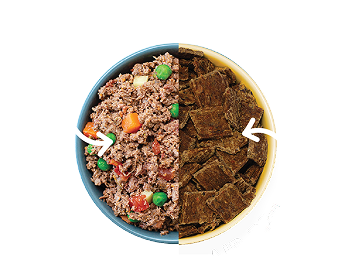
Prebiotics, Probiotics, and Postbiotics for Dogs
Biotics this, biotics that. You probably know a bit about probiotics from caring for your own digestive health. But probiotics for dogs, along with prebiotics and postbiotics, might be a new concept. What in the world are pre, pro, and postbiotics for dogs, and what do they have to do with your pup’s health?
We’ll break it down one biotic at a time. Let’s start with a quick review of what probiotics do for dogs.
Probiotics — for a healthy microbiome
We all have bacteria, both good and bad, in our bellies. The good guys are known as probiotics, and they play an important role in gastro-intestinal (GI) health.
Turns out that the bad bacteria doesn't like to party with the good ones. Probiotics are beneficial because they help keep bad bacteria under control.
So, when it comes down to what probiotics do for your dog’s (or your own) belly, an optimal, healthy microbiome has levels of probiotics that:
- Help reduce and improve irritation in the GI tract
- Improve immune system function and skin health
Probiotics come from the fermentation processes of certain foods, like kefir milk, goat’s milk, or yogurt. They are also readily available in supplement form, which makes them easy to add to any diet, including your dog’s.
Next, we’ll look at prebiotics and postbiotics for dogs — the two other parts of the probiotic system.
Prebiotics — to feed the probiotics
Remember how we said probiotics come from the fermentation process of certain foods? Well, prebiotics are what feeds probiotic growth. These soluble, fermentable fibers are “a type of nondigestible carbohydrate, also called resistant starch” in foods like chicory root.
Keep in mind that prebiotics and probiotics for dogs work together. Too much prebiotic action without the right amount of probiotics to process it can result in GI issues such as loose stools.
But assuming there is a solid pre- and probiotic balance for your dogs, foods high in prebiotic fibers help promote the survival of the probiotics, which paves the way to the natural production of postbiotics.
Postbiotics — the product of healthy probiotics
Postbiotics, also known as postbiotic metabolites, are the product of well-fed probiotics. The best way to get them is to put probiotics into the belly, and be sure to feed those probiotics with prebiotics.
When your dog digests food, all those beneficial probiotics transform food into “hundreds of thousands of metabolites,” that nurse the walls of the gastro-intestinal tract so it stays healthy.
These postbiotic powerhouses include amino acids, vitamins, and short-chain fatty acids, all of which promote healthy bodily function and growth in your dog.
How to get the right biotics into your dog’s belly
If you want to get more probiotics into your dog’s diet, first take a look at the main course you feed your dog every day. Then, you can add supplements or special treats chosen to help build a healthier microbiome in your dog’s belly.
- Start with a healthy main course. One way to proceed is to feed your dog fresh, whole foods like A Pup Above. These recipes are rich in fiber to naturally aid your dog’s digestion.
- Supplements just for your dog. If your dog’s belly needs a bit more help in the digestion department, talk to your vet first. Then, check your local independent pet supply retailers for their selection of probiotic supplements or goats milk for dogs.
- Feed your dog’s probiotics with prebiotics. Remember that prebiotics need probiotics or you might get loose stools. Look for prebiotic supplements with ingredients such as chicory root, Jerusalem artichokes, lactoferrin, and soybeans.
- Probiotic treats you can make. Add goat’s milk or kefir milk into your pup’s daily routine for a natural probiotic. These milks are excellent supplemental probiotic foods for your dog, and they can be made into fun frozen treats that can entertain your canine.
Top Stories

Why Do Dogs Lick Their Paws?

Why Do Dogs Whimper & Make Noises in Their Sleep?

Healthy Vet-Approved Homemade Dog Food Recipes

How To Cook Sweet Potatoes for Dogs






















